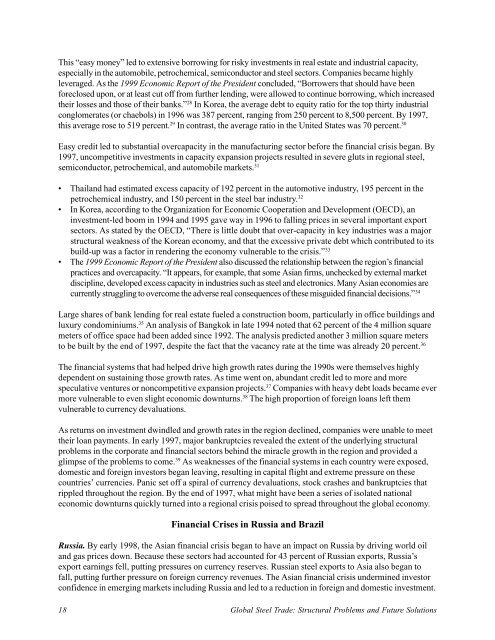Global Steel Trade; Structural Problems and Future Solutions
Global Steel Trade; Structural Problems and Future Solutions
Global Steel Trade; Structural Problems and Future Solutions
You also want an ePaper? Increase the reach of your titles
YUMPU automatically turns print PDFs into web optimized ePapers that Google loves.
This “easy money” led to extensive borrowing for risky investments in real estate <strong>and</strong> industrial capacity,<br />
especially in the automobile, petrochemical, semiconductor <strong>and</strong> steel sectors. Companies became highly<br />
leveraged. As the 1999 Economic Report of the President concluded, “Borrowers that should have been<br />
foreclosed upon, or at least cut off from further lending, were allowed to continue borrowing, which increased<br />
their losses <strong>and</strong> those of their banks.” 28 In Korea, the average debt to equity ratio for the top thirty industrial<br />
conglomerates (or chaebols) in 1996 was 387 percent, ranging from 250 percent to 8,500 percent. By 1997,<br />
this average rose to 519 percent. 29 In contrast, the average ratio in the United States was 70 percent. 30<br />
Easy credit led to substantial overcapacity in the manufacturing sector before the financial crisis began. By<br />
1997, uncompetitive investments in capacity expansion projects resulted in severe gluts in regional steel,<br />
semiconductor, petrochemical, <strong>and</strong> automobile markets. 31<br />
• Thail<strong>and</strong> had estimated excess capacity of 192 percent in the automotive industry, 195 percent in the<br />
petrochemical industry, <strong>and</strong> 150 percent in the steel bar industry. 32<br />
• In Korea, according to the Organization for Economic Cooperation <strong>and</strong> Development (OECD), an<br />
investment-led boom in 1994 <strong>and</strong> 1995 gave way in 1996 to falling prices in several important export<br />
sectors. As stated by the OECD, “There is little doubt that over-capacity in key industries was a major<br />
structural weakness of the Korean economy, <strong>and</strong> that the excessive private debt which contributed to its<br />
build-up was a factor in rendering the economy vulnerable to the crisis.” 33<br />
• The 1999 Economic Report of the President also discussed the relationship between the region’s financial<br />
practices <strong>and</strong> overcapacity. “It appears, for example, that some Asian firms, unchecked by external market<br />
discipline, developed excess capacity in industries such as steel <strong>and</strong> electronics. Many Asian economies are<br />
currently struggling to overcome the adverse real consequences of these misguided financial decisions.” 34<br />
Large shares of bank lending for real estate fueled a construction boom, particularly in office buildings <strong>and</strong><br />
luxury condominiums. 35 An analysis of Bangkok in late 1994 noted that 62 percent of the 4 million square<br />
meters of office space had been added since 1992. The analysis predicted another 3 million square meters<br />
to be built by the end of 1997, despite the fact that the vacancy rate at the time was already 20 percent. 36<br />
The financial systems that had helped drive high growth rates during the 1990s were themselves highly<br />
dependent on sustaining those growth rates. As time went on, abundant credit led to more <strong>and</strong> more<br />
speculative ventures or noncompetitive expansion projects. 37 Companies with heavy debt loads became ever<br />
more vulnerable to even slight economic downturns. 38 The high proportion of foreign loans left them<br />
vulnerable to currency devaluations.<br />
As returns on investment dwindled <strong>and</strong> growth rates in the region declined, companies were unable to meet<br />
their loan payments. In early 1997, major bankruptcies revealed the extent of the underlying structural<br />
problems in the corporate <strong>and</strong> financial sectors behind the miracle growth in the region <strong>and</strong> provided a<br />
glimpse of the problems to come. 39 As weaknesses of the financial systems in each country were exposed,<br />
domestic <strong>and</strong> foreign investors began leaving, resulting in capital flight <strong>and</strong> extreme pressure on these<br />
countries’ currencies. Panic set off a spiral of currency devaluations, stock crashes <strong>and</strong> bankruptcies that<br />
rippled throughout the region. By the end of 1997, what might have been a series of isolated national<br />
economic downturns quickly turned into a regional crisis poised to spread throughout the global economy.<br />
Financial Crises in Russia <strong>and</strong> Brazil<br />
Russia. By early 1998, the Asian financial crisis began to have an impact on Russia by driving world oil<br />
<strong>and</strong> gas prices down. Because these sectors had accounted for 43 percent of Russian exports, Russia’s<br />
export earnings fell, putting pressures on currency reserves. Russian steel exports to Asia also began to<br />
fall, putting further pressure on foreign currency revenues. The Asian financial crisis undermined investor<br />
confidence in emerging markets including Russia <strong>and</strong> led to a reduction in foreign <strong>and</strong> domestic investment.<br />
18 <strong>Global</strong> <strong>Steel</strong> <strong>Trade</strong>: <strong>Structural</strong> <strong>Problems</strong> <strong>and</strong> <strong>Future</strong> <strong>Solutions</strong>
















